You’re lounging around on the couch, waiting for Game of Thrones to come on and wondering what it’s like to own a Direwolf. Just as the opening music starts, your very own Rover comes and presses a rope toy into your leg, tail wagging and eyes hopeful. He wants to play tug. But why?
Why Do Dogs Like Tug of War So Much? There Are a Few Potential Reasons…
The reality is, it’s pretty hard to know exactly why dogs like tug of war so much. (So far, we haven’t figured out how to ask our dogs what’s going on in their mind).
While we can’t know for sure, we do have a few good guesses as to why dogs like tug of war so much.
According to most scientists and modern dog trainers, there are three main explanations for why dogs like tug of war so much.
Reason 1: It’s a Collaborative Game
In this explanation, dogs play tug as a way to strengthen bonds. It’s a fun game that can be played between two dogs.
Play is a great way to build trust between two parties, and tug is a great game to play that uses different muscles and parts of the brain from chase or wrestling.
This doesn’t really explain why it’s fun, though. Since most play and games in mammals originates with a function (chase games strengthen muscles and practice for the hunt, for example), it’s fair to assume that tug of war has a purpose behind its play. That’s where the next two explanations come in.
Reason 2: It Mimics Predation
This explanation suggests that tugging on a rope toy is like shaking and killing some imaginary prey. This makes sense, as it’s a functional game.
Your doe-eyed Rover is actually practicing his ripping, tearing, and tugging skills for when he gets ahold of the Easter Bunny! This makes that fun rope toy game a bit darker, doesn’t it?
Personally, I think this explanation better suits dogs that shake, squeak, and then pull the stuffing out of squeaky toys. Tug is a team game, whereas this type of predation is not.
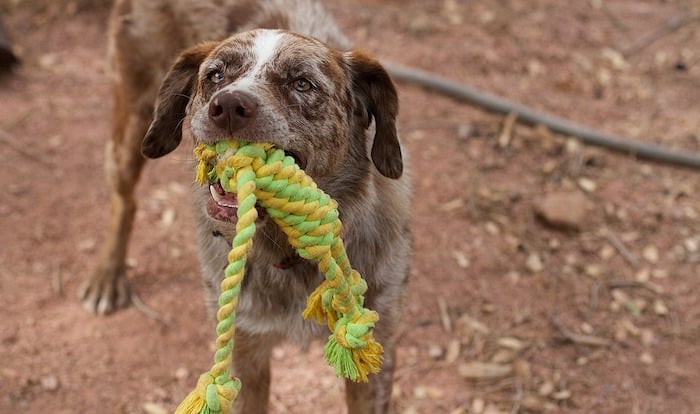
Reason 3: It’s Like Tearing Up A Carcass
This is my favorite explanation.
The idea here is that tug is actually a game based off of tearing bits off of a dead animal. Still morbid, yes – but instead of shaking and killing a small mammal, tug is a game based off of pulling hard-to-detach morsels off of a dead elk or deer. They might do this on their own by pulling meat from a bone, or two dogs might help each other tear off bits of food.
Most trainers don’t view tug as a competition. If the goal were to win (taking all the meat for themselves in this explanation), why would Rover come back for more when you drop the toy? It’s fun and games – not a competition!
Regardless of whether Rover is trying to finish the hunt by shaking and killing his prey, or trying to tear bits of food from a bone, tug is a fun way to spend time with your dog.
With some rule-setting, tug is a great way to build bonds and work on some basic training.
The Benefits of Playing Tug With Your Dog
There are plenty of reasons for humans to love to play tug of war, too. There are many benefits to playing tug of war with your dog. Benefits of playing tug of war with your dog include:
- Exercise. Tug of war is a great way to get some energy out! It’s hard to beat tug as a game that you can play indoors that burns off some energy on cold or rainy days. Just be sure to keep an eye on your dog’s neck, back, and shoulders to avoid injury!
- Collaboration. Tug is a collaborative game that can help build relationships between dog and owner. Many trainers prefer tug over fetch for that reason – it’s a better way to bond.
- Teeth cleaning. Some tug toys are specially designed to help floss your dog’s teeth. While I haven’t seen any specific studies about how effective this is, many websites talk about the benefits of flossing tug toys.
- Satisfaction of instincts. Whether dogs are practicing for the kill or preparing to rip apart their food, tug is an instinctive game that serves a purpose. Since your dog likely doesn’t get to do either of these activities in his daily life, tug is a great way to get that urge out!
- Increase confidence. Some shy dogs really open up with a good game of tug. Playing this collaborative game can help them come out of their shell, build their confidence, and help them trust people more. It might take a while to coax them into playing with you, but once they tap into that instinct (mentioned above), many dogs really light up!
- Training. You can use tug of war as a reward during training or even use the game itself as a way to train your dog new things. We’ll cover that in-depth later.
The Tug of War Controversy & Dominance Theory
Dominance. It’s a big scary word that’s thrown around a lot by dog owners, trainers, and veterinarians. It’s why you should never let your dog win tug. Right?
Right?
Well, probably not. Dominance, pack theory, and “alpha” explanations are all pretty poorly supported by science.
The American Veterinary Society of Animal Behavior, who know much more about this than you and I do, put out this position statement urging veterinarians, owners, and trainers to abandon “dominance theory” as it relates to dog-human relationships.
For a slightly easier-to-read breakdown of the science surrounding dominance theory, check out Dr. Sophia Yin’s instructive article on the dominance controversy. It’s got great videos demonstrating more scientifically sound ways to train dogs that avoid “dominance,” pain, fear, and intimidation!
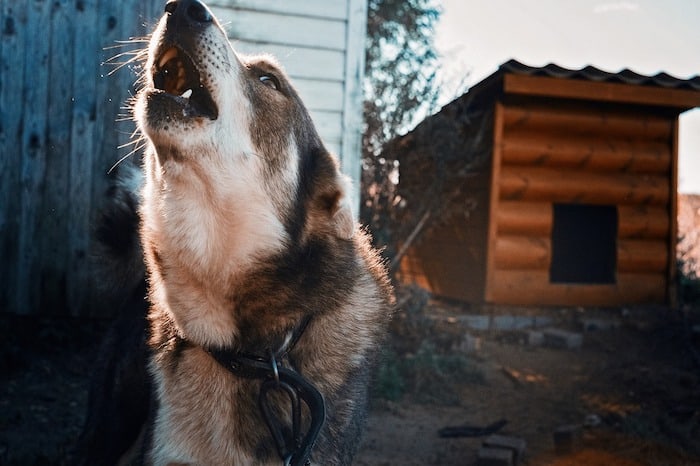
So, how does this whole debunked dominance theory relate to tug of war?
You’ve probably heard it before. You have to “win” the game 100% of the time. Or maybe the human has to win 90% of the time. Perhaps you always have to initiate the game. Breaking any of these rules runs the risk of letting Rover get it into his head that he rules the roost. And then before you know it, Rover will be sitting in your favorite spot on the couch, eating your chips and downing your favorite flavors of seltzer water like he owns the place.
While I don’t have an issue with many of these rules, I do take issue with the underlying beliefs. Letting Rover win tug of war won’t mean that he’s suddenly alpha, leader of the pack, and dominant over you – don’t stress about it!
While winning is a non-issue, there are a few different rules we suggest you implement while playing a round of tug. These rules keep everyone safe and happy!
The 10 Rules of Tug
Rules around the game of tug are important. I always recommend playing tug of war with your dogs only with certain rules in place.
These rules are meant to keep the game fun and safe for everyone – not to stop Rover from taking over your house.
Rule #1. Humans Initiate Tug of War – At Least At First
It might be cute at first when Rover presses a toy into your leg. But if Rover’s a total tug fiend, this can get annoying fast.
The goal of this rule is to teach your dog that being pushy and demanding with the toy doesn’t earn him the right to play. Otherwise, you risk teaching your dog to follow you around barking until you take up the tug!
Avoid demanding dogs by only playing tug when you initiate the game – at least at first.
Demanding dogs aren’t trying to dominate you – they just want you to do fun things with them. Teach your dog that he gets good things by being polite instead of rude, and your life together will be much easier.
After six months of owning Barley, I’m finally letting him start some games of tug. I ignore him if I’m not in the mood or busy, and then reward him with a cookie when he gives up and goes to lie down.
Rule #2. Rover Drops The Tug Toy When Asked
This is really important for your safety, but that’s not why I always do it with my own dog.
I constantly practice asking Barley to “drop it” during tug games because that’s a great way to practice the “drop it” cue!
If Barley can spit out a tug toy when he’s in the middle of his second-favorite game (fetch is his favorite), he’s more likely to spit out that dead squirrel on our next run.
I taught Barley to do this willingly by asking him to spit out the toy every 3-5 seconds during tug games. If he spits the toy out, I praise him and we start the game again. Rinse and repeat. If he doesn’t spit the toy out, I drop it and walk away. Game over!
This bums him out (more evidence that he’s not trying to “win” any game here) and he follows me around with the toy. I don’t start tug again unless he drops the toy and sits down.
Rule #3. When the Human Says the Game is Over, the Game is Over
This ties into both rules #1 and #2. It’s a way to teach your dog impulse control, which is key to listening when you say “drop it.” It’s also a way to avoid creating a demanding dog.
I teach this by having one cue to drop the toy and pause the game (drop it) and another cue to end the game (all done).
When I want tug of war time to be over, I ask Barley to drop the toy. When he does, I say “all done,” put the tug toy away, and give him a stuffed Kong or other edible chew toy. The stuffed Kong gives him something else to do, is a good reward for listening to me, and helps calm him down.
Rule #4. If Rover’s Teeth Ever Touch His Human’s Hand, It’s Game Over
This rule is why I love tug of war. When Rover starts to learn that teeth on human skin makes the fun end, he’ll start learning bite inhibition. Read more about teaching bite inhibition in the “Teaching Through Tug” section of this article.
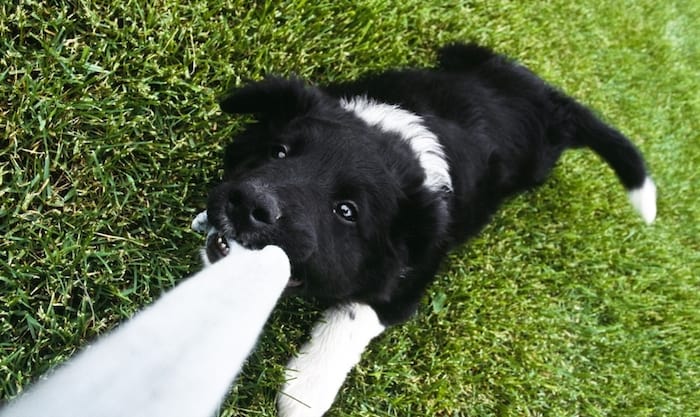
Rule #5. Tug of War Only Happens With Certain Toys
This rule should be easy if you follow Rule #1 (only play tug when the humans initiate the game).
This is important for keeping your dog and his toys safe. Some toys aren’t made to stand up to tug of war games. If they tear or break, they might be dangerous to your dog.
When I adopted Barley, he had a bad habit of trying to play tug with his frisbee. He destroyed two while the dogsitter was over because she didn’t know that we only play tug with rope toys! Now I communicate this rule to everyone who plays with Barley.
Rule #6. If the Human Can’t Control the Game, the Human Can’t Play the Game
This means small children shouldn’t play tug with large dogs for safety reasons. It also means that if you’ve just adopted a 120 pound St. Bernard who has no manners, you probably shouldn’t play tug yet.
Rover needs to have some manners before you play – this keeps everyone safe.
Rule #7. Dogs With a History of Resource Guarding or Human-Directed Aggression Shouldn’t Play Tug
If your dog stiffens, stares, growls, or worse when you try to take toys away, he’s not a good candidate for tug of war. Even if your dog loves tug of war, your safety comes first.
The same goes for dogs that have a history of being aggressive towards people that they know.
Talk to a certified trainer (IAABC or APDT) if you’re not sure whether or not it’s safe to play with your dog.
Some dogs that are fearful or aggressive towards strangers might still be able to play with their beloved owners, while others should play more hands-off games entirely.
Rule #8. Dogs With Fragile Teeth Shouldn’t Play Tug
It should go without saying that dogs with dental issues shouldn’t be playing tug. It’s not worth the veterinary bills, no matter how much your dog likes tug of war.
Check with your vet if you’re not sure what your dog’s dental condition is like! Little pups should often hold off on rough games of tug, as their baby teeth can pop out.
While those puppy teeth will come out eventually, losing them in a game of tug can potentially upset the direction of your dog’s adult teeth, so make sure your pup is dentally-cleared for tug by your vet before playing.
Rule #9. Dogs With Neck, Shoulder, or Back Issues Shouldn’t Play Tug
This also seems obvious, but it should be said. It’s easy for dogs to strain their muscles, just like their human parents!
If you notice that Rover is stiff or hesitant to move, see your vet right away and stop playing tug. It could just be a little soreness or muscle knot, but you don’t want a vigorous game of tug to hurt your dog further!
Rule #10. When Rover Drops the Toy on Cue, the Human Pays Rover For His Hard Work
Our last rule is for the humans. So far, most of the above rules dictate that the dog must do what the human wants. That’s how most dog-human relationships work – but I firmly believe that this is a two way street.
When a dog does what I ask him to do (drop a tug toy, come when called), I should pay him for his work. I wouldn’t do my job without being paid, even though I love the work and I love my boss. The same goes for dogs!
As Grisha Stewart says in her excellent dog training manual, if you can’t think of a reason for your dog to listen to you, he probably can’t either.
I implement this by frequently re-starting the tug game when Barley drops. He learns that listening when I say “drop it” actually re-starts the game! When the game is over, I give him an edible chew item to reward him for exercising restraint and listening to me.
It’s ok if you don’t always have treats on you or a way to reward Rover. The key is to reward him often enough that he’s still happy to comply when you ask him to stop the fun!
Want more tips on proper tug play? Check out the video below with advice from dog training pro Victoria Stilwell:
Teaching Through Tug: Why Humans Should Love Tug, Too!
When you’ve got the rules laid out and tug toys at the ready, it’s time to play some tug! Dogs like tug of war, and it’s a fun way to spend time with your dog. But if you want, playing tug of war with your dog is also a great way to teach some manners and tricks!
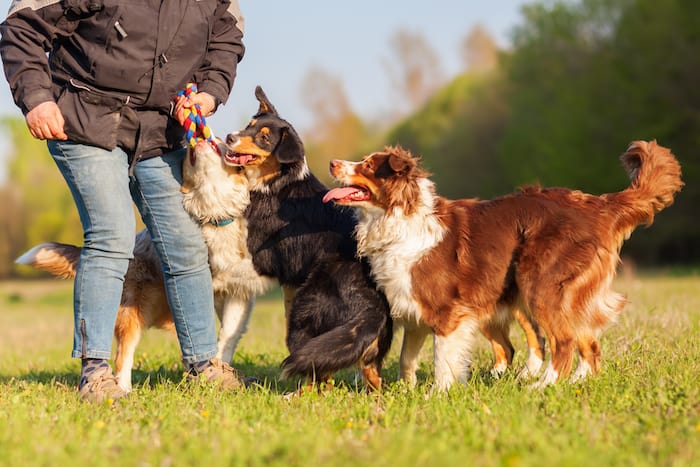
You can use tug of war to teach your dog:
Impulse Control
Many dogs struggle with impulse control. These dogs struggle to think clearly and respond to cues when they’re excited.
If you practice asking your dog to drop the toy in the midst of a good tugging bout, this is a great way to practice impulse control! When your dog is a champ at dropping the tug toy as soon as you ask, you can start asking him to “drop it,” then “sit” before getting the toy back!
Teaching your dog to respond to cues when he’s amped up is easy when you use tug as a teaching game!
Bite Inhibition
This is one of the most important skills a dog can have – to moderate his teeth around human hands. All dogs can and will bite, so how hard they bite is important. Tug is a great way to teach your dog to mind his teeth.
You can either end the game entirely when Rover’s teeth touch your hand, or you can take a 10-30 second timeout. I simply say “ouch!” and drop the tug toy, then turn my back on Barley for a few seconds. When he drops the toy and sits, I’ll start the game again.
In operant conditioning terms, this is negative punishment. Basically, we’re reducing an unwanted behavior (teeth on fingers) by taking away something good (the fun tug game). We then use positive reinforcement by giving the dog a good thing (the tug game) in order to reward a good behavior (sitting calmly).
New Tricks
If your dog simply adores tug of war, you can use it as a training tool!
I used tug of war as a reward for Barley at the end of each Nosework class. Tug is a great way to finish up a training session or reward your dog for learning something new.
I recommend following up tug sessions with a more relaxing activity like Karen Overall’s Mat Protocol so that Rover doesn’t finish a training session turned to 100mph!
Not to mention, collaborative games like tug are a great way to bond with your dog!
Training through tug is the main reason that many trainers love tug of war so much – myself included. Try out some of these skills and maybe you’ll start loving tug as much as Rover already does!
Trainer’s Top Tug Toys: Our Recommend Picks
Ready to get started? Let’s look at a few good tug toys that you can get on Amazon so that you can start enjoying tug with your dog ASAP!
For the Tug Maniacs: Mammoth Flossy Chews Cottonblend Color 5-Knot Rope Tug – I love this super-long tug toy for games. It also comes in a five-foot-long version. It’s particularly great for big dogs, dogs that adjust their grip frequently, or overly exuberant starters. The length of this toy has saved my fingers a few times when Barley lunged for it a bit too fast in a burst of excitement!
For the Small but Mighty: Otterly Pets Puppy Dog Pet Rope Toys For Small to Medium Dogs is perfect for smaller dogs. It’s actually a pack of four different tug toys, so you can try them all out and see what Rover likes best! This is also a great option for multi-dog households.
For the Dentist’s Dog: Booda Fresh N Floss 3 Knot Tug Rope Dog Toy is actually made with real dental floss. It also contains baking soda to help fight plaque and tartar. Best of all, it comes in plenty of sizes for different dogs. If you only get one tug toy, this might be your best bet – it kills all the birds with one stone.
The bottom line is, tug of war is a game and it’s fun! That’s why even if your dog “wins” the game, he often comes back for more. Tug is a game – not a struggle for dominance!
Does you dog love tug? How to do you feel about it? Share your thoughts in the comments!





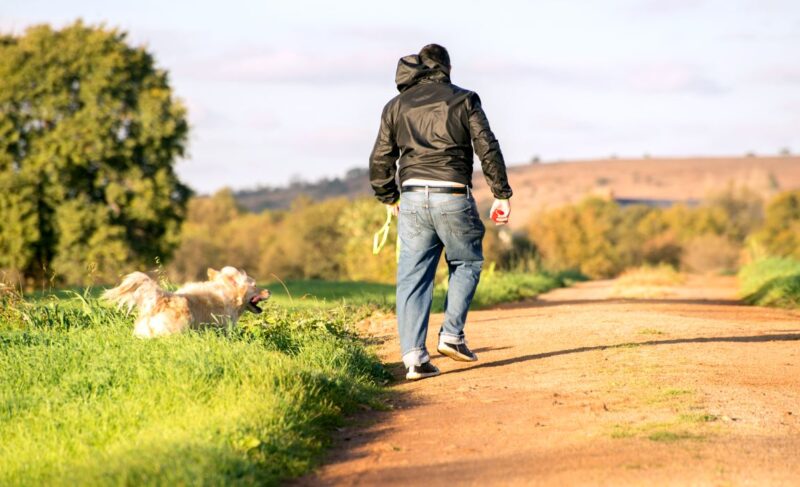
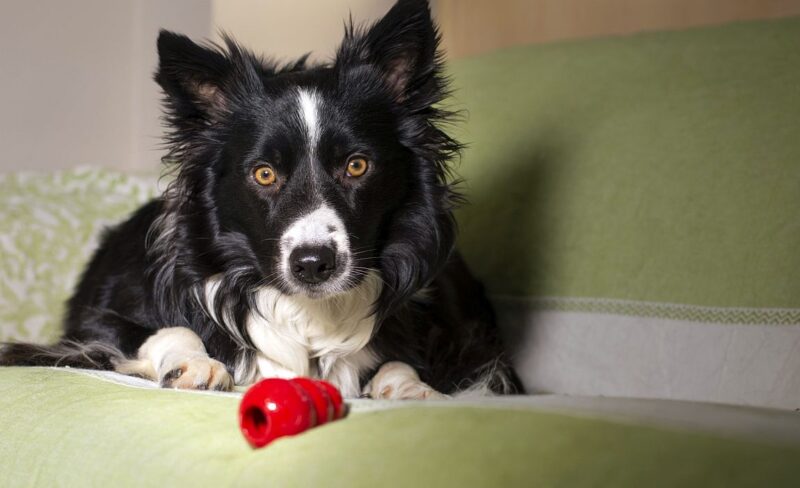

Leave a Comment